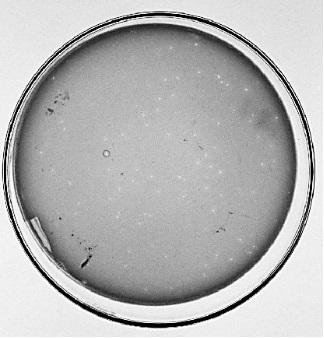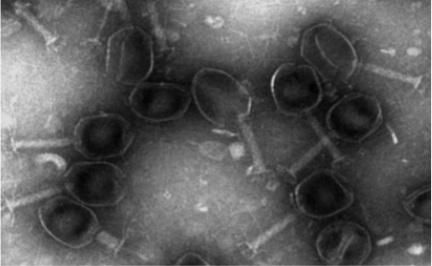A kind of coliphage and its application
A technology of Escherichia coli and bacteriophage, which is applied in the field of bioengineering to achieve strong killing activity, low toxic and side effects, and high safety
- Summary
- Abstract
- Description
- Claims
- Application Information
AI Technical Summary
Problems solved by technology
Method used
Image
Examples
Embodiment 1
[0029] Example 1 Phage Isolation and Preparation
[0030] Streak-inoculate the host bacteria on 1.2% LB agar medium, culture overnight, pick a single clone and inoculate it in 1ml LB liquid medium, culture it with shaking at 37°C for 5-6 hours, and use it as the host bacteria culture for later use.
[0031] In the summer of 2016, sewage from a goose farm in Changzhou City, Jiangsu Province was collected, and the supernatant was filtered through double-layer filter paper, centrifuged at 10,000rpm for 20min, and then filtered with a 0.22μm filter membrane; 10mL of the filtered supernatant was added to 0.5mL of the host bacteria Overnight culture, followed by sterile CaCl 2 After mixing the mother liquor to a final concentration of 1.25mM, add 20ml of LB liquid medium, react at room temperature for 30min, and place it at 37°C for 6-8h; then take the culture and centrifuge at 12000rpm, 4°C for 30min, and take the supernatant; 10mL of this supernatant was added to 0.5mL of the ove...
Embodiment 2
[0034] Example 2 Phage Amplification and Purification
[0035] On the double-layer plate forming plaques in Example 1, use the tip of a pipette to pick up a single plaque with a larger diameter, inoculate it in 3-5 ml LB liquid medium, and add 0.1 ml of phage host bacterial solution. mL, mix well, act at room temperature for 15 minutes, incubate at 37°C for 10-14 hours, centrifuge at 12,000 rpm, 4°C for 10 minutes, take the supernatant, add 0.3% chloroform; repeat the double-layer experiment, and pick a single phage plaque repeatedly 4-5 times. Purify the phage into plaques of equal size.
[0036] Take 1 mL of freshly cultured host bacteria and add 0.3 mL of phage lysate (the ratio of a single phage culture to host bacteria is 1:1, 1:10 and 1:100, respectively). Incubate at 37°C for 20 minutes to make the phage particles adsorb to the host bacteria; add 100mL LB liquid medium, then add CaCl 2 The mother solution was grown to a final concentration of 1.25mM, shaken at 37°C fo...
Embodiment 3
[0041] Example 3 Transmission electron microscope observation of bacteriophage vB_EcoM_C1
[0042] Take the PEG-purified phage in Example 2 for electron microscope observation. The specific operation steps are: add 10 μL of the sample and drop it on the copper grid, wait for it to settle for 15 minutes, absorb the excess liquid with filter paper, and use 2% phosphotungstic acid (PTA) Stain for 1-2min, observe with a transmission electron microscope (Hitachi H-7650) after drying; the observation results are as follows figure 2 As shown, the head is in the shape of an icosahedron, the diameter of the head is about 80 nm, and the length of the tail is about 110 nm. According to the "Classification of Viruses—The Eighth Report of the International Committee on Taxonomy of Viruses" published by the International Committee on Taxonomy of Viruses (ICTV) in 2005, vB_EcoM_C1 belongs to the family Myoviridae ( Myoviridae ).
PUM
| Property | Measurement | Unit |
|---|---|---|
| diameter | aaaaa | aaaaa |
| diameter | aaaaa | aaaaa |
Abstract
Description
Claims
Application Information
 Login to View More
Login to View More - R&D Engineer
- R&D Manager
- IP Professional
- Industry Leading Data Capabilities
- Powerful AI technology
- Patent DNA Extraction
Browse by: Latest US Patents, China's latest patents, Technical Efficacy Thesaurus, Application Domain, Technology Topic, Popular Technical Reports.
© 2024 PatSnap. All rights reserved.Legal|Privacy policy|Modern Slavery Act Transparency Statement|Sitemap|About US| Contact US: help@patsnap.com










